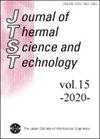燃烧衍生氧化镁纳米片对棕榈油生物柴油-柴油混合燃用柴油机燃烧、排放及功能特性的影响
IF 0.9
4区 工程技术
Q3 THERMODYNAMICS
引用次数: 1
摘要
本研究旨在探讨分散溶液燃烧衍生的氧化镁纳米片(~17 nm)在生物柴油-柴油混合燃料和纯柴油纳米燃料中的作用和影响,以研究单缸电负荷水冷柴油发动机的功能和污染物排放。本研究的重点燃料是棕榈油生物柴油和分散在50 ppm氧化镁纳米片中的普通柴油的混合物,以及分散在50 ppm氧化镁纳米片中的纯柴油。将这些燃料与作为基本参考燃料的普通柴油以及生物柴油-柴油混合物进行比较。通过实验测量,我们推断燃料密度、黏性和热值随着纳米薄片的加入而增强。在发动机性能属性方面,颗粒分散生物柴油-柴油混合燃料和颗粒分散柴油分别降低了制动比油耗(BSFC) 3.08%和2.88%,而颗粒分散生物柴油-柴油混合燃料和颗粒分散柴油分别提高了制动热效率(BTE) 5.04%和2.74%。在排放指标上,颗粒分散生物柴油-柴油混合柴油的未燃烃(UHC)、CO、颗粒物排放或烟气、氮氧化物(NOx)分别降低了9.51%、18.71%、13.64%和5.63%,颗粒分散柴油分别降低了10.35%、16.54%、13.64%、19.47%和4.70%。来本文章由计算机程序翻译,如有差异,请以英文原文为准。
Role of combustion derived magnesia nanoflakes on the combustion, emission and functional characteristics of diesel engine susceptible to palm oil biodiesel-diesel blend
This research article intends to discuss on the role and effects of dispersing solution combustion derived magnesia nanoflakes (~17 nm) within the biodiesel-diesel blends and pure diesel termed as nanofuels, in order to investigate the functional and pollutant emissions of a single-cylinder, electrically loaded, water-cooled diesel engine. The fuels focussed in this study are a blend of palm oil biodiesel and regular diesel dispersed with 50 ppm magnesia nanoflakes, and a pure diesel dispersed with 50 ppm magnesia nanoflakes. These fuels are compared with regular diesel which is considered as the base reference fuel, as well as with the biodiesel-diesel blend. From the experimental measurements, we inferred that the fuel density, viscous nature, and calorific value enhanced with the addition of nanoflakes. As for the engine performance attributes, the brake specific fuel consumption (BSFC) is lessened by 3.08% and 2.88% for particle dispersed biodiesel-diesel blend and particle dispersed diesel, respectively, whereas the brake thermal efficiency (BTE) enhances by 5.04% for particle dispersed biodiesel-diesel blend and 2.74% for particle dispersed diesel. With reference to emission, the unburnt hydrocarbon (UHC), white damp (CO), particulate exhaust or smoke, and the nitrogen oxides (NOx) are reduced by 9.51%, 18.71%, 13.64%, and 5.63%, respectively for particle dispersed biodiesel-diesel blend and 10.35%, 16.54%, 13.64%, 19.47%, and 4.70%, respectively for particle dispersed diesel. To
求助全文
通过发布文献求助,成功后即可免费获取论文全文。
去求助
来源期刊
CiteScore
2.30
自引率
8.30%
发文量
0
审稿时长
5 months
期刊介绍:
JTST covers a variety of fields in thermal engineering including heat and mass transfer, thermodynamics, combustion, bio-heat transfer, micro- and macro-scale transport phenomena and practical thermal problems in industrial applications.

 求助内容:
求助内容: 应助结果提醒方式:
应助结果提醒方式:


